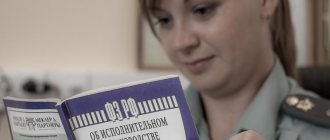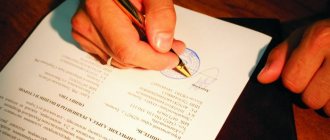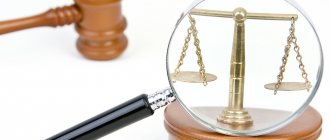Important! If you are handling your own theft case, you should remember that:
- Each case is unique and individual.
- Knowledge of the laws is desirable, but does not guarantee a solution to your particular problem .
- The possibility of a positive outcome depends on many factors .
Get a free consultation with a lawyer with the support of the Ministry of Justice of the Russian Federation
When investigating various categories of crimes, including thefts, special knowledge is required to secure evidence or establish certain facts. For this purpose, forensic examinations are appointed. The expert's opinion will be one of the most important evidence in the case.
Forensic characteristics of thefts
The concept of theft is disclosed in Art. 158 of the Criminal Code of the Russian Federation is the theft of someone else’s property or funds with the aim of disposing of them at one’s own discretion or converting them in favor of other persons. A feature of this type of act is the absence of signs of violent actions when taking possession of other people’s valuables, as well as the secret nature of the thief’s actions.
Let us highlight the important nuances that characterize the theft of money or property assets:
- it is considered an administrative offense if the amount of damage does not exceed 2,500 rubles;
- Art. 158 of the Criminal Code of the Russian Federation contains a delimitation of the amount of damage, which affects the punishment of the offender:
- significant size (at least 5,000 rubles);
- major damage (at least 250 thousand rubles);
- especially large size (at least a million rubles);
Art. 158 of the Criminal Code of the Russian Federation contains a number of additional factors that influence the possible type of punishment:
- amount of damage;
- crime of a group of persons or an organized group;
- theft from someone else's home;
- theft from personal belongings or items that were with the victim, etc.
Note!
Most of the indicated signs of theft can only be proven with the help of examinations ordered by an investigator or court.
General rules
The limited operational resource, characteristic of assets in the category under consideration, determines the onset of a moment at which the original functionality cannot actually be implemented, either partially or completely. Keeping fixed assets on the balance sheet in such a situation is impractical and unprofitable, and also contradicts legal requirements, therefore, in the case of an inventory, penalties may be applied to the responsible entities.
To put it briefly, accounting for the disposal of fixed assets is the documentation of a write-off indicating the reason, which may include:
- Wear and tear of the property fund (both physical and moral).
- Destruction resulting from extraordinary circumstances.
- Damage to property - both intentional and accidental.
- Theft or shortage identified during the audit.
- Sale for the purpose of generating income, as well as transfer as part of an exchange or gift.
- Execution of an act of transfer to a deposit forming the authorized capital of another organization.
- Expiration of the period allotted for the redemption of the leased object.
This list is not exhaustive, so examples of reasons for disposal of fixed assets for accounting may differ. The key reason is the lack of possibility of further operation, confirmed by the result of the next inventory or a separate document. It is worth noting that local movement between divisions of one enterprise does not qualify for the status in question and does not require the preparation of documents of this kind.
Based on the provisions established within the Chart of Accounts, as well as in the accompanying Instructions for Use, opening a subaccount to account 01 is permitted regardless of the factor that is the root cause. This recommendation is based on Order No. 94n of 2000 of the Ministry of Finance of the Russian Federation.
Expenses associated with the disposal of fixed assets from the organization are taken into account and reflected in the following accounting entries. As part of the review, let us consider, as an example, subaccount 01/B, to which the primary cost of fixed assets, previously listed in relation to the object in account 01, is written off. Thus, posting D 01/B - K 01 is generated.
The next stage is the write-off of the depreciation accumulated over the period of operation, the value of which is determined at the time the asset is excluded. The standard formulation is used here: Debit 02 - Credit 01/B, while the result of reflection is the resulting residual value. The value determined on the main or subaccount is subject to further liquidation from the balance sheet through a procedure during which the entire amount is written off.
The role of forensic examinations in theft investigation
Forensic examination is an independent procedural event, its procedure is regulated by the Code of Criminal Procedure of the Russian Federation. A specialist with special knowledge in the field of science, technology, etc. is appointed to carry it out.
Let us highlight the main characteristics of such studies, which determine their important role in the investigation of thefts:
- the examination can be carried out at the pre-investigation stage or after the initiation of a case;
- the expert's conclusion is recognized as evidence in the case;
- All participants in a criminal case (investigator, victim accused, lawyer, etc.) have the right to propose questions.
Note!
If doubts arise about the objectivity or reliability of the specialist’s conclusions, the participants in the case have the right to file a petition for a repeat or additional examination. An unjustified refusal to satisfy such a request may be appealed to a higher official, prosecutor or in court.
Transfer as a contribution to the authorized capital
This option for disposing of assets involves the use of the corresponding account 58 - “Financial investments”. Taking into account the fact that when making a share expressed not in monetary form, an independent expert is required to evaluate the object, and at the same time, the interested parties to the transaction themselves do not have the right to insist on a higher value - there is a possibility of a difference between residual and estimated value recorded on account 91.
It is also worth noting that resident enterprises that pay VAT are required to restore the tax applied to the object. The amount is entered by the transferring entity into the accompanying documentation, and after completion of the procedure it can be deducted from the recipient party, while for the investor it is determined in the structure of financial investments. The algorithm established for its calculation, enshrined in Article 170 of the Tax Code, provides for the use of a proportion relative to the residual value of retired fixed assets.
To make it clearer, consider a clear example of such a situation. Let's say an enterprise uses OS as a contribution, transferring assets worth 560,000 rubles into the authorized capital (let's denote it StOS). Depreciation charges (AmOC) recorded at the time of transfer amounted to 139,000 rubles. The value stated by an independent valuation expert, and determined excluding VAT, is equal to 480 thousand, which was confirmed by the corresponding decision of all participants in the organization.
The amount of value added tax (VAT), previously adopted for the object in question, is equal to 112,000 rubles, which allows us to calculate the amount to be restored. As a result of simple calculations, the desired value will be 84,200 rubles:
NDSV = NDSP * ((StOS - AmOS) / StOS)
To reflect retired fixed assets in the balance sheet of an enterprise, it will be sufficient to complete the following entries:
| Action | D | TO | Sum, thousand rubles |
| Write-off of original cost | 01/B | 01 | 560 |
| Depreciation at the time of transfer | 02 | 01/B | 139 |
| Reflection based on the approved results of an independent expert assessment | 58, “Financial investments”, s/s “Units and shares” | 76, “Mutual settlements” | 480 |
| Write-off of residual item | 76 | 01/B | 421 (560-139) |
| VAT recovery | 19, “VAT on acquisitions” | 58, s/s “Units and shares” | 84,2 |
| Inclusion of tax collection in the investment structure | 58, s/s - the same | 19 | 84,2 |
| Reflecting the positive difference | 76 | 91, s/s “Other” | 59 (480-421) |
In situations where the result of comparing the estimate and the current value turns out to be negative, other expenses actually arise, reflected in the entry D91 - K76.
The most typical forensic examinations in the investigation of thefts
Based on the characteristics of a crime such as theft, the following types of forensic examinations can be distinguished:
- fingerprinting – an expert examines fingerprints found at a crime scene or stolen objects to identify the criminal;
- traceological - study of traces of a criminal, a break-in at a residential premises or locks on a storage facility, etc.;
- merchandising - signs of stolen valuables are established, the correspondence of some of the found items to the remaining lot, etc.;
- accounting - in case of theft of goods from an enterprise, when it is necessary to establish the amount of damage based on primary receipt documents;
- other types in various fields of science, craft, technology, etc.
The burden of proving guilt in committing a crime rests with the prosecution. Since the inquiry officer or investigator does not have the specified special knowledge, only the conclusions of an expert can clarify certain facts.
To get the most detailed advice on your issue, you just need to follow any of the suggested options:
|
Write-off of assets retired due to an emergency or identified shortage
Just as in the previous case, the removal from the balance sheet of actually missing property of an enterprise, lost due to emergency events or as a result of unknown circumstances, is recorded by the accounting department as an expense item. At the same time, it is worth noting that a prerequisite is the organization of an unscheduled inventory, based on the results of which an act is formed confirming the fact of absence.
Recommendations based on the provisions of the orders of the Ministry of Finance boil down to accounting for losses from the disposal of fixed assets in account 94 (“Shortage or damage to property assets”, D94 - K01/B), and then, due to the absence of culprits and responsible entities, to reclassification as “ Other expenses" (D91 - K94). The same algorithm is also used in situations where the loss of one of the operating systems is a consequence of the influence of unidentified factors, and is discovered already in the process of a planned audit.
Mobile solutions offered by . allow you to simplify and automate accounting. Specialized software guarantees operational control over balances and helps track the entire product distribution cycle.
The importance of examinations for investigation
The expert's conclusion must accurately answer all the questions set out in the decision of the investigator or court. If violations are detected during the examination or the specialist does not have the necessary qualifications, the document may be considered unacceptable evidence. In this case, the lawyer will file a motion to exclude him from the case file, which will significantly complicate the process of incriminating evidence in criminal proceedings.
The expert’s conclusions allow us to establish the following circumstances:
- the identity of the criminal and his sanity - when examining traces of a crime (fingerprints, shoe prints, etc.);
- the exact size of the stolen property;
- method of theft - by illegally entering someone else's home, etc.;
- the presence of mitigating and aggravating circumstances.
The expert's conclusions will be assessed by the court when considering the case materials. If they contradict, a repeat or additional examination may be prescribed.
If you were robbed, what to do?
Ordinary people and businesses can equally become victims of a crime such as theft. However, only bringing the guilty person to criminal liability is often not enough to compensate for the damage caused.
What actions should be taken next?
Naturally, it is necessary to immediately write a statement to the police about the theft of property. It can be submitted either to the department at the residence address of the injured party or at the place where the crime was committed.
The statement describes the circumstances under which the theft of property occurred and provides a list of it.
If there is an assumption about who is involved in the theft, then it is worth carefully mentioning this too (in no case in the form of a denunciation, otherwise there is a risk of being brought to criminal responsibility).
You must also indicate the total value of the stolen property. This figure will become the basis for a future claim for damages.
Typically, three days are given to make a decision in a criminal case.
After this, an application must be written to the investigator to recognize the civil plaintiff and attach to the materials of the criminal case a claim for compensation for damages from the crime. It can come from both a citizen and an enterprise.
Petition to recognize the victim as a civil plaintiff
Application to the court for recognition as a civil plaintiff
Moral damage in case of theft or theft of property
Along with direct property losses caused by the crime, the victim has the right to make moral claims.
Compensation for moral damage in case of theft occurs when the victim is an individual. In this case, the person himself determines the monetary equivalent in which he is ready to evaluate his own moral suffering.
In order for compensation for moral damages in case of theft of property to have real prospects, the claim must contain the type and degree of mental suffering caused. It would not be amiss to provide documentary evidence.
We recommend! How to recover moral damages for emotional distress caused
For example, as a result of theft, a person received a psychological disorder. Then a medical report and a copy of prescriptions (receipts) for the purchase of sedatives and other drugs will come in handy.
The injured party has the right to file a claim for moral damage together with a demand to recover material damage from the culprit. For each amount, the court makes its decision separately, along with the imposition of punishment for the crime committed.







